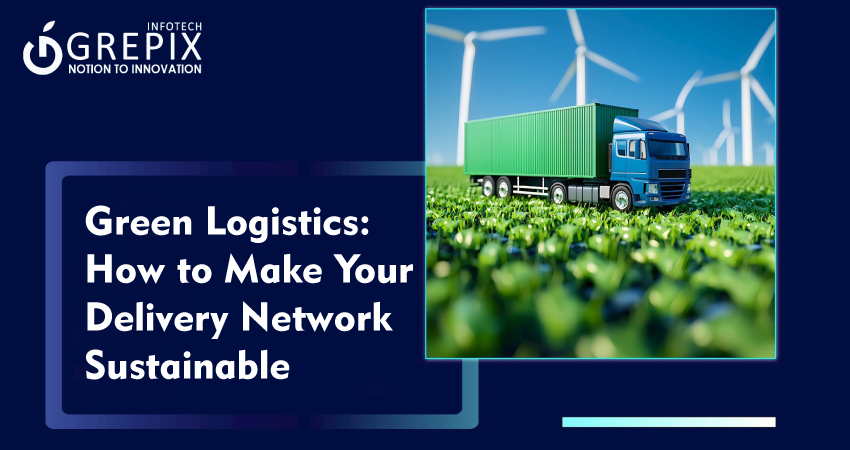Green Logistics: How to Make Your Delivery Network Sustainable
Sustainability has shifted from a “nice-to-have” to a core business strategy in logistics. Transport accounts for almost a quarter of global greenhouse gas emissions, forcing companies to prioritize eco-friendly logistics and carbon footprint reduction delivery from first mile to last. Consumer surveys show roughly 80% of buyers prefer sustainable delivery options, and more than two-thirds actively seek brands using green logistics apps and a sustainable delivery network.
Pressure from regulators, investors, and customers drives logistics firms toward lower emissions, greener vehicles, and optimized packaging. The green logistics market itself is booming valued at $1.54 trillion in 2024 and set to more than double by 2034 with digital tools fueling this explosive growth.
Green logistics is transforming the delivery and supply chain sector, empowering businesses to build sustainable delivery networks through eco-friendly practices, advanced technologies, and smart apps. Leading brands, from Amazon and DHL to local innovators, leverage green logistics apps, electric vehicles, and carbon footprint reduction delivery strategies to meet environmentally conscious consumer demands. This guide explains essential concepts, highlights industry statistics, and offers actionable strategies. You'll learn about sustainable packaging, carbon reduction, and how green logistics apps streamline eco-friendly logistics, reduce emissions, and enhance customer loyalty in today's competitive marketplace
Importance of Green Logistics
Consumer Demand for Sustainability
More than ever, consumers scrutinize logistics providers and demand both quick and eco-friendly delivery. In a 2025 survey, 80% of buyers said they’d trade speedy shipping for greener options, while 68% searched for brands committed to environmental responsibility. Companies using green logistics apps and emphasizing a sustainable delivery network enjoy higher conversion rates and customer retention.
Compliance, Cost Savings, and Market Advantage
Environmental regulations are tightening worldwide. Governments push for carbon neutrality and stricter waste management, compelling businesses to adapt or face penalties. Early adopters of eco-friendly logistics find themselves ahead, saving on fuel and packaging, optimizing delivery routes, and often attracting valuable ESG-focused investors.
Statistics & Growth Trends
- The global green logistics market reached $1.54 trillion in 2024, expected to hit $3.39 trillion by 2034 (CAGR 8.21%).
- The Asia-Pacific region is the largest market, driven by EV adoption and logistics technology.
- IoT devices and green logistics apps save billions of dollars worldwide, mainly through real-time tracking, predictive maintenance, and route optimization.
Eco-Friendly Vehicles: Powering the Sustainable Delivery Network
Eco-friendly vehicles are at the heart of green logistics, with electric, hybrid, and even hydrogen-powered fleets expanding in fast-growing delivery markets.
Electric Delivery Vehicles & Hybrids
- Electric trucks and vans reduce urban emissions and cost less to run per mile.
- Leading companies like Amazon and IKEA aim for 100% electric last-mile delivery in key cities.
- Hybrid vehicles bridge the gap, allowing for lower emissions even on longer intercity routes.
- Governments in countries such as Japan, India, and Germany provide tax breaks and incentives for companies investing in green fleets.
Alternative Delivery Methods
Bikes, e-scooters, and even delivery on foot are increasingly used for urban last-mile logistics, reducing both costs and carbon footprint. Green logistics apps enable dynamic dispatch and route planning for these new vehicle types.
| Vehicle Type | Key Benefit | Example Use |
|---|---|---|
| Electric Van | Zero tailpipe emissions | Urban last mile |
| Hybrid Truck | Reduced fuel consumption | Long/short haul |
| E-bike | Lower congestion/zero CO₂ | Dense urban routes |
| Hydrogen Vehicle | Fast refuel, clean emission | Long distance |
Sustainable Packaging: Reducing Waste, Boosting Customer Loyalty
Packaging is often the first touchpoint for a sustainable brand experience. Eco-friendly logistics means more than just the vehicle it’s about the box too.
Smart Packaging Strategies
- Switch to Recycled Materials: Major retailers now require all suppliers to use a set percentage of recycled cardboard or biodegradable plastics in packaging.
- Optimize Package Design: Right-sizing reduces void fill, lowers shipping volume, and cuts costs, with AI-driven green logistics apps making optimization easy.
- Reusable Packaging Initiatives: Some grocers and delivery companies use totes or insulated bags collected for reuse, significantly shrinking landfill contributions.
Case Study: Circular Packaging
DHL’s “GoGreen” program uses returnable packaging in Germany and the Netherlands. Over 70% of packages in select pilot cities are now reused at least twice before recycling.
Carbon Reduction Strategies with Green Logistics Apps
Digital transformation is unlocking huge environmental wins for supply chains. Green logistics apps and real-time tracking have become indispensable tools for a sustainable delivery network.
Route Optimization
Green logistics apps like Route4Me reduce mileage, idle time, and fuel use by mapping the shortest, most efficient routes. Route optimization of even 10% can lower logistics emissions by millions of tons annually.
Driver Behavior and Fleet Analytics
These tools:
- Monitor driver behaviors (aggressive acceleration, braking)
- Track real-time CO₂ emissions and fuel consumption per trip
- Benchmark drivers to identify and reward efficiency
Businesses leveraging these analytics typically cut emissions 10–30% within the first year, according to a 2025 market review.
Partnerships & Clean Energy
- Switching to renewable energy for warehouses and charging stations
- Partnering with local fleets to transition vehicles to electric or biofuels
Global Regulatory Trends
- India’s Unified Logistics Interface Platform (ULIP) helps firms share emissions data for carbon audits and improvement.
- Europe mandates lower-emission options for fleet replacement and eco-friendly logistics compliance in cross-border shipping.
Real-World Examples & Case Studies
- Amazon: Targets net-zero carbon by 2040. Its global fleet now includes over 100,000 electric delivery vehicles, and all North American fulfillment centers use solar or wind energy.
- IKEA: Opened urban “micro-depots” to enable zero-emission bike deliveries in Paris, London, and New York, reducing last-mile CO₂ by up to 90% in these cities.
- Route4Me: Helped logistics companies cut more than 10 billion tons of CO₂ emissions, optimizing 10 billion miles of routes since 2010 through its green logistics app.
- Alibaba Cainiao: Provides 72-hour global delivery with smart logistics parks enabling real-time emission tracking and reusable packaging systems.
How to Make Your Delivery Network Sustainable: 8 Steps
- Audit Your Current Carbon Footprint: Use analytics and green logistics apps to measure baseline emissions per delivery.
- Adopt Electric or Hybrid Vehicles: Leverage available government incentives.
- Implement Route Optimization Software: Reduce empty miles and driver idle time.
- Source Sustainable Packaging: Prioritize recyclable or reusable materials.
- Train Drivers in Eco-Safe Practices: Encourage smooth driving, anti-idling behaviors.
- Set Up Urban Hubs: Bring distribution centers closer to end-customers.
- Use Last-Mile Alternatives: Integrate e-bikes, scooters, and walking routes.
- Monitor and Report: Share sustainability data with consumers and regulators for transparency.
The Role of IoT and Automation in Green Logistics
IoT-powered sensors track real-time vehicle location, speed, temperature, and humidity during delivery. Automation in warehousing such as robotic sorting and climate control slashes energy use. According to industry estimates, IoT and automation can drive up to 30% more efficiency in eco-friendly logistics.
Green Logistics: Global Initiatives and Market Leaders
Countries worldwide recognize the value of sustainable delivery networks.
- Japan: Automakers are at the forefront of commercial EV deployment.
- India: Government’s ULIP platform is a model for digital carbon tracking in logistics.
- China: Alibaba’s logistics division prioritizes 24–72-hour green delivery domestically and abroad.
- Germany: Legislative reforms ensure all fleet upgrades comply with strict EU emissions standards.
Common Challenges & Solutions
- High Upfront Cost: Electric vehicles, automation, and monitoring tools require substantial investment, though rapidly improving ROI due to efficiency.
- Integration Complexity: Not all green logistics apps easily connect with legacy systems choose modular, API-first platforms.
- Change Management: Staff and partners may resist new processes; invest in training and clear communication.
Conclusion
Green logistics is essential for any serious delivery network aiming for growth, profitability, and a positive brand image. By integrating green logistics apps, investing in eco-friendly vehicles, and adopting robust carbon footprint reduction delivery strategies, businesses future-proof operations and meet rising customer expectations. The path to building a sustainable delivery network starts with small steps measuring, optimizing, and innovating at every turn.
Now is the time to act: audit current practices, choose powerful green logistics apps, and create value through eco-friendly logistics. Ready to reduce the carbon footprint of your deliveries? Start your journey toward a sustainable delivery network today and join the movement for a greener tomorrow then share these insights to help others make smarter, more sustainable logistics choices.
FAQs
1. What are green logistics apps, and how do they help?
Green logistics apps optimize routes, track emissions, and provide real-time analytics to minimize fuel use, reduce idle time, and lower the carbon footprint of delivery networks.
2. What vehicles best support a sustainable delivery network?
Electric and hybrid vehicles are ideal for eco-friendly logistics, with e-bikes and even hydrogen vehicles suited to various delivery distances and cargo sizes.
3. How can companies reduce their packaging carbon footprint?
Switch to recycled/reusable packaging, right-size packages, and use AI-powered apps to design and track sustainable packaging plans.
4. What is the ROI on implementing green logistics strategies?
Most companies see a 10–30% reduction in costs and emissions within the first year by adopting green logistics apps and route optimization.
5. Which industries benefit most from sustainable delivery networks?
Retail, e-commerce, and food/grocery delivery see the biggest gains from cost savings to improved brand loyalty when deploying eco-friendly logistics solutions.







